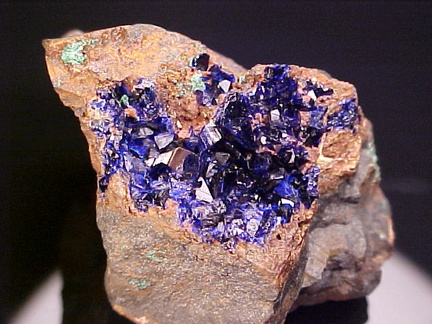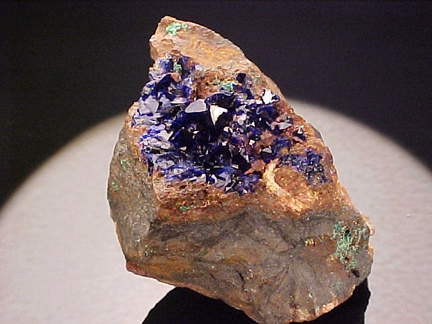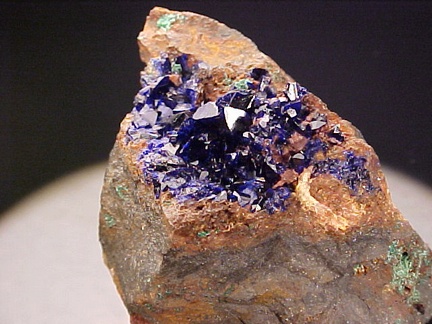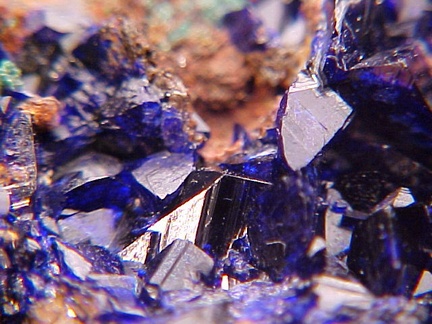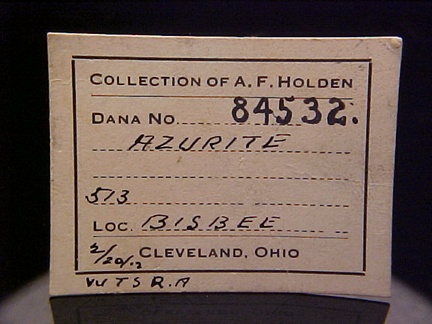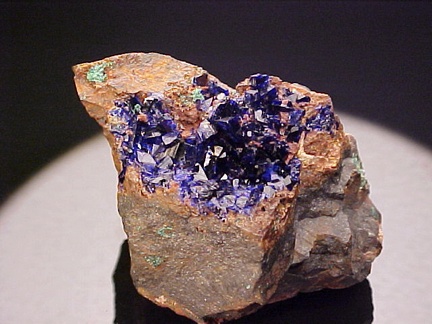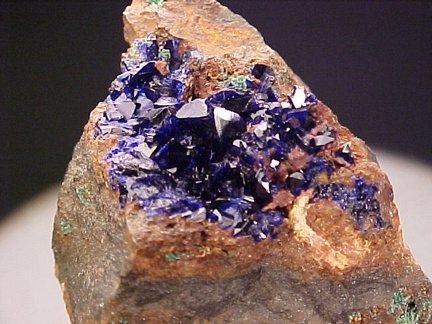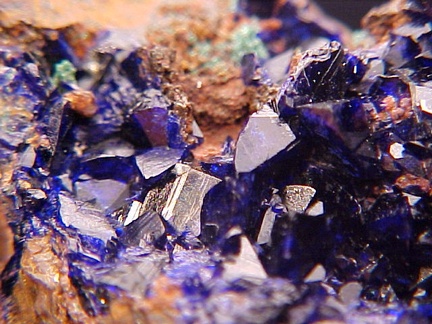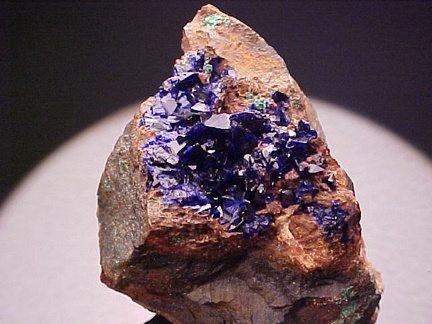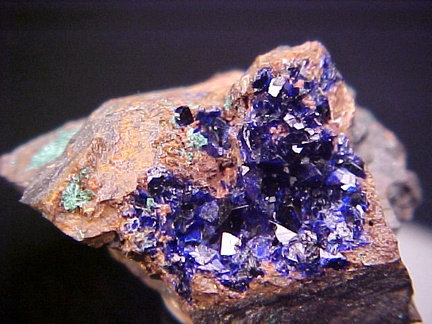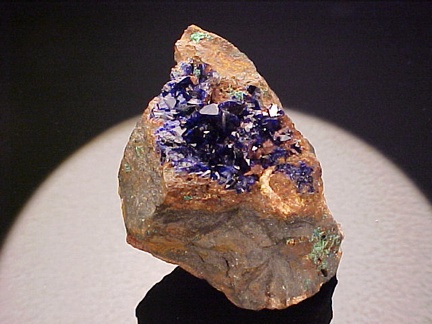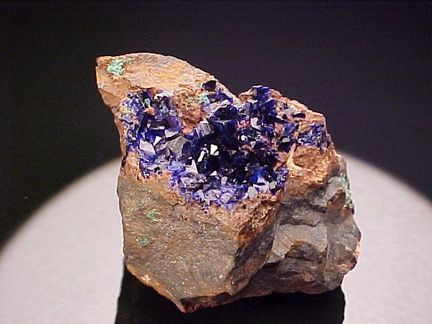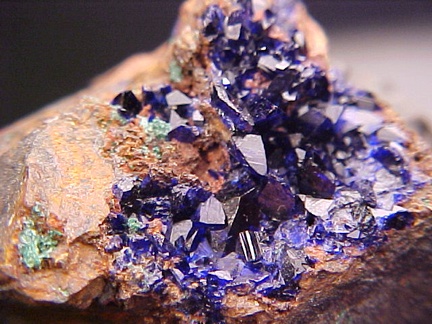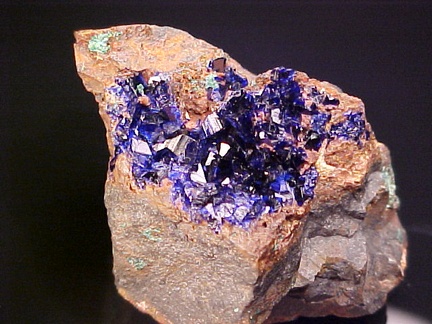An old time example of azurite from Bisbee!!! This specimen hosts a handsome showing of sharp, lustrous, intensely colored
azurite crystals on matrix!!! The azurite crystals have choice lively royal blue color!!! This specimen is from the collection of
Albert F. Holden and retains its original collection label!!! Albert Holden (1863-1913)was a well known mineral collector with a rather exciting
history!!! The following excerpt is taken from the Mineralogical Record's label archive:
Albert F. Holden
(1863-1913)
Albert Fairchild "Bert" Holden was born in 1866, the third of nine children born to Delia
Bulkley and Liberty Holden. His mother was instrumental in founding the Cleveland School
of Art, which later became the Cleveland Institute of Art. His father was an attorney and
mining man who made his fortune in the silver mines of Utah, became an important art
collector, and at one time was the owner of Cleveland's major newspaper, The Plain Dealer.
The family moved to Salt Lake City before 1880, where Liberty Holden attended to his
mining interests, and Albert attended school.
Albert Holden graduated from Harvard with a degree in Mining Engineering in 1888.
Following graduation he rejoined his father in the silver fields of Utah. Some of Albert's
mineral labels are marked "Salt Lake City" (other, presumably later, examples are marked
"Cleveland, O."). In 1899, he purchased his father's mines in Bingham Canyon and organized
the United States Mining Company to consolidate his interests. He also purchased the
Centennial Eureka Mining Company, the Old Telegraph mine, and the Old Jordan and Galena
Mining Company. Silver, gold, lead and copper ores were shipped from his many mines to his
five-stack smelter on the banks of the Jordan River near the Great Salt Lake. By 1906 he
had created the second largest mining and smelting trust in the world; a serious
competitor to the American Smelting and Refining Company (ASARCO). In that year he also
formed a company to operate gold and silver mines in Mexico, and made numerous trips
there, acquiring hundreds of mineral specimens for his collection while doing business. He
befriended Pancho Villa (probably financially), and consequently while other American-owned
mines in Mexico were being plundered by Villa and his revolutionaries, Holden's properties
were never touched.
As the output of Holden's mines increased, he built an even larger smelter at Bingham
Junction and established the Unites States Smelting Company to operate it. He also
purchased other smelting facilities, including the DeLamar Copper Refining Company of
New Jersey and the Mammoth Copper Mining Company in California. The Mammoth mines at that
time were the largest producers of copper in California. He also founded the Island Creek
Coal Company to supply his furnaces. With his new smelters in full operation, his
reduction works and his copper and lead refineries, Holden could compete with any trust,
and became very wealthy. Today, Kennecott Copper Corporation's enormous Bingham Canyon
mine in Utah incorporates the mines once owned by Liberty and Albert Holden.
In addition to being an enthusuastic mineral collector and a botanist, Holden was also a
serious coin collector. He obtained the personal 1907 Ultra High Relief double eagle
($20 gold piece) owned by renowned artist Augustus Saint-Gaudens (it would later be the
world's first gold coin to sell for more than $1 million) in 1907, directly from the
family of sculptor Saint-Gaudens, who had designed the coin. Holden's daughter, Emery May,
inherited it, and it became a centerpiece of the legendary coin collection she and her
husband, U.S. Ambassador R. Henry Norweb, assembled over the decades.
Although Holden had considered bequeathing his estate to his alma mater, the untimely
death of his 12-year old daughter, Elizabeth, inspired him instead to endow the Holden
Arboretum in his home town of Cleveland, Ohio in her memory. However, he did also endow
the mineralogy department at Harvard, and he donated his substantial mineral collection
to Harvard in 1911; it is today preserved in its original cabinet in the Harvard
Mineralogical Museum. Holden died of cancer in 1913 at the age of 46. The mineral
holdenite was named in his honor by Charles Palache in 1921, and a species of lilac,
syringa vulgaris, is named the "Albert F. Holden lilac" in his honor. The coal mining
town of Holden, West Virginia also traces its name to him. He was inducted posthumously
into the Mining Hall of Fame in 1990.
Good luck and be sure to check out my other exciting mineral auctions on ebay!!!
STAY TUNED!!! MORE AUCTIONS
WILL BE ADDED SATURDAY NIGHT FOR A SPECIAL 5-DAY AUCTION, ENDING THURSDAY OCTOBER 22nd!!!
We are constantly acquiring new exciting specimens & old collections!!! BE THE FIRST TO FIND OUT WHAT'S NEW & CHECK OUT OUR
Ebay "About Me" page!!!
ALSO, CHECK BACK OFTEN BECAUSE WE WILL BE ADDING MORE UPDATES AND SPECIMENS IN THE UPCOMING WEEKS!!!

